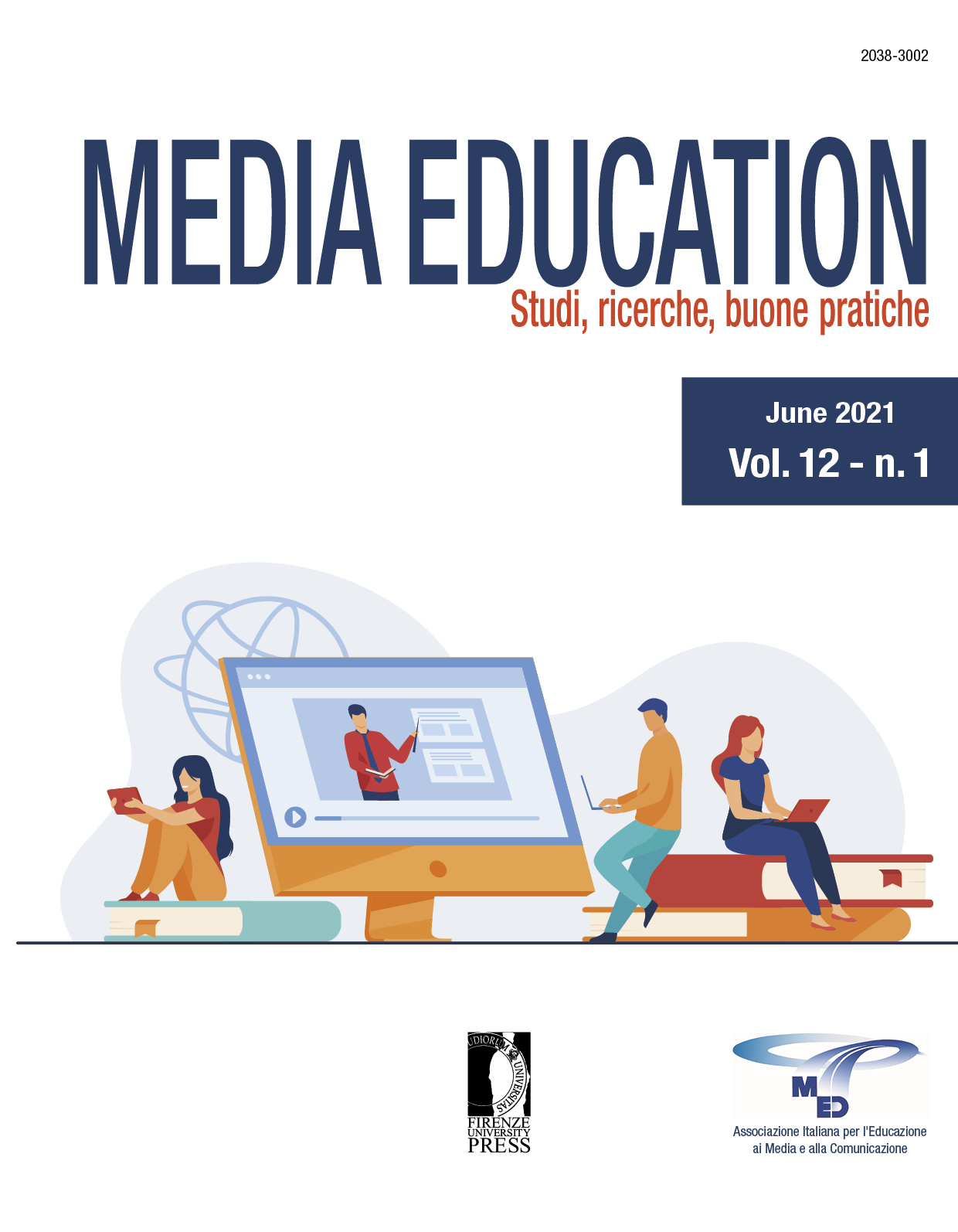Published 2021-05-03
Keywords
- educommunication,
- childhood,
- media literacy,
- pre-school education,
- teacher training
Abstract
Media literacy is based on dimensions that include a series of indicators that address knowledge, skills and attitudes of the so-called media competence. The purpose of this study is to facilitate the promotion of media competence in the Second Cycle of Early Childhood Education, for which it is necessary to carry out a selection and adaptation of the dimensions and indicators in relation to the characteristics of the child, which facilitate its implementation in the classroom by teachers and the progressive acquisition of this competence in students. An exhaustive review of the literature on media literacy and in relation to the nature of childhood is carried out in order to adapt the indicators to the particularities of this educational stage.
References
- AIMC (Ed.) (2018). Más del 40% de los niños ve contenidos televisivos en los dispositivos móviles o el ordenador. Asociación para la Investigación de los Medios de Comunicación. https://bit.ly/2U64s3x
- AIMC (Ed.) (2019). Marco General de los Medios en España 2019. Asociación para la Investigación de los Medios de Comunicación. https://bit.ly/2U5d36q
- Aparici, A., Campuzano, A., Ferrés, J., & Matilla, A. (2010). La educación mediática en la escuela 2.0. https://goo.gl/oMVqbZ
- Berk, LE (2001). Desarrollo del niño y del adolescente. Pearson Educación.
- Bernabeu, N., Esteban, N., Gallego, L., & Rosales, A. (2011). Alfabetización mediática y competencias básicas. Proyecto Mediascopio Prensa. La lectura de la prensa escrita en el aula. Madrid, España: Mediascopio. https://goo.gl/k2XO0n
- Busemann, A. (1985). Psicología de la segunda infancia y de la edad juvenil. En D. Katz., A. Busemann., J. Piaget., B. Inhelder. Psicología de las edades. Del nacer al morir, 83‐121. Morata.
- Celot, P., & Pérez-Tornero, J.M. (2009). Study on Assessmente Criteria for Media Literacy Levels. A comprehensive view of the concept of media literacy and an Understanding of how media literacy level in Europe Should Be Assessed. European Commision.
- De Andrés, T. (2006). El desarrollo de la inteligencia fílmica. La comprensión audiovisual y su evolución en la infancia y adolescencia. CNICE.
- Di Croce, D. (2009). Media Literacy. Teacher Resource Guide. Canadian Broadcasting Corporation.
- Eleá, I. (Ed.). (2014). Agentes e Vozes. Um panorama da mídia-educação no Brasil, Portugal e Espanha. Nordicom.
- Erstad, O., Miño, R., & Rivera-Vargas, P. (2021). Educational practices to transform and connect schools and communities. [Prácticas educativas para transformar y conectar escuelas y comunidades]. Comunicar, 66, 9-20. https://doi.org/10.3916/C66-2021-01 DOI: https://doi.org/10.3916/C66-2021-01
- Ferrés, J. (2007). La competencia en comunicación audiovisual: propuesta articulada de dimensiones e indicadores. Quaderns del CAC, (29), 9-17.
- Ferrés, J., & Piscitelli, A. (2012). La competencia mediática: propuesta articulada de dimensiones e indicadores. Comunicar, 19(38), 75-82. DOI: https://doi.org/10.3916/C38-2012-02-08
- Gaitán, L. (2010). Ser niño en el siglo XXI. Cuadernos de pedagogía, (407), 12-16.
- García-Ruíz, R., Duarte, A., & Guerra, S. (2014). Propuesta de un instrumento de evaluación para medir el grado de competencia mediática en la etapa de educación infantil. Pixel-bit. Comunicación, Lenguaje y Educación, 44(44), 81-96. https://doi.org/10.12795/pixelbit.2014.i44.06 DOI: https://doi.org/10.12795/pixelbit.2014.i44.06
- Gozálvez, V. (2012). Ciudadanía mediática. Una mirada educativa. Dykinson.
- Jiménez-Morales, M., Montaña, M., & Medina-Bravo, P. (2020). Childhood use of mobile devices: Influence of mothers’ socio-educational level. Comunicar, 64, 21-28. https://doi.org/10.3916/C64-2020-02 DOI: https://doi.org/10.3916/C64-2020-02
- Katz, D., Busemann, A., Piaget, J., & Inhelder, B. (1985), [1960]. Psicología de las edades. Del nacer al morir. Morata.
- Kotilainen, S., & Kupiainen, R. (2015). Reflections on media education futures. Nordicom: University of Gothenburg.
- Lachat, C. (2011). Didáctica de la traducción audiovisual: enseñar a mirar. Redit, (6), 94-105.
- Palacios, J., & Mora, J. (1999). Crecimiento físico y desarrollo psicomotor hasta los 2 años. En J. Palacios., A. Marchesi., y E. Coll. Desarrollo psicológico y educación. 1. Psicología evolutiva (págs. 81-102). Alianza.
- Pavez, I. (2012). Sociología de la Infancia: las niñas y los niños como actores sociales. Revista de Sociología, (7), 81-102. DOI: https://doi.org/10.5354/0719-529X.2012.27479
- Pérez-Rodríguez, A., & Delgado-Ponce, A. (2012). From digital and audiovisual competence to media competence: Dimensions and indicators. Comunicar, 39, 25-34. https://doi.org/10.3916/C39-2012-02-02 DOI: https://doi.org/10.3916/C39-2012-02-02
- Pérez-Rodríguez, MA, Ramírez, A., & García-Ruiz, R. (2015). La competencia mediática en Educación Infantil. Análisis del nivel de desarrollo en España. Universitas Psychologica. 2(14) 619-630. https://goo.gl/I3PNZR DOI: https://doi.org/10.11144/Javeriana.upsy14-2.cmei
- Pérez-Tornero, J.M., & Pi, M. (2014). La educación en medios en una España en crisis. En I. Eleá. Agentes e vozes. Um panorama da mídia-educaçao no Brasil, Portugal e Espanha, 247-256). Nordicom.
- Rafael, A. (2009). Desarrollo cognitivo: las teorías de Piaget y de Vygostky. Colegio Oficial de Psicólogos de Cataluña. AUB (Universidad Autónoma de Barcelona). https://goo.gl/FKq49n
- Rodríguez, I. (2000). ¿Sociología de la infancia? Aproximaciones a un campo de estudio difuso. Revista Internacional de Sociología (RIS). Tercera Época, (26). 99-124. https://goo.gl/H9Ndec
- Zacchetti, M., & Vardakas, P. (2008). A European approach to media literacy. In U. Carlsson, S. Tayie, G. Jacquinot-Delaunay, & J. M. Pérez Tornero (Eds.), Empowerment through media education: an intercultural dialogue, 117-123. Nordicom, Göteborgs universitet.

